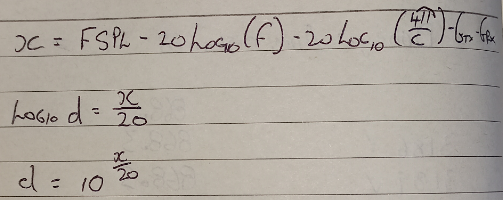You are using an out of date browser. It may not display this or other websites correctly.
You should upgrade or use an alternative browser.
You should upgrade or use an alternative browser.
Find d
- Thread starter johans
- Start date
topsquark
Senior Member
- Joined
- Aug 27, 2012
- Messages
- 2,363
You essentially haveHi,
My maths from 20 years back I have forgotten.
I need to find the value of d
View attachment 32272
FSPL = -93
f = 868000
GTX = 6
GRX =3
c = 299792458
I cant recall how to manipulate the formula to find d, please help
[imath]log_{10}(d) = A[/imath]
where A is some constant.
What is [imath]10^{log_{10}(d)}[/imath]? (Hint: [imath]log_{10}(x)[/imath] is the inverse function of [imath]10^x[/imath].)
-Dan
The Highlander
Senior Member
- Joined
- Feb 18, 2022
- Messages
- 1,192
Maybe his/her difficulty is in finding "A". ?You essentially have
[imath]log_{10}(d) = A[/imath]
where A is some constant.
What is [imath]10^{log_{10}(d)}[/imath]? (Hint: [imath]log_{10}(x)[/imath] is the inverse function of [imath]10^x[/imath].)
-Dan
Harry_the_cat
Elite Member
- Joined
- Mar 16, 2016
- Messages
- 3,779
Can you simplifyHi,
My maths from 20 years back I have forgotten.
I need to find the value of d
View attachment 32272
FSPL = -93
f = 868000
GTX = 6
GRX =3
c = 299792458
I cant recall how to manipulate the formula to find d, please help
\(\displaystyle -93 = 20 \log_{10}(d) + 20 \log_{10}(868 000) + 20\log_{10}(\frac{4\pi}{299 792 458}) - 6 - 3\)
down to
\(\displaystyle -93 = 20\log_{10}(d) + ??\)
The basic idea is this definition of logarithms.
[math]\text {Given } \alpha > 0, \ \alpha \ne 1, \text { and } \beta > 0, \\ \log_{\alpha}(\beta) = \gamma \iff \beta = \alpha^{\gamma}.[/math]
(From that definition, topsquark’s hint follows directly, but I actually think it is easier to work from the definition itself.)
The Cat has given you one method, but I find it a bit easier to go
[math]-93 = 20 \log_{10}(d) + 20 \log_{10}(868000) + 20 \log_{10} \left ( \dfrac{4 \pi}{299792948} \right ) - 3 - 6 \implies \\ - 84 = 20 \log_{10} + 20 \log_{10} \left ( \dfrac{3.472 * 10^6 * \pi}{2.997,929,480 * 10^8} \right ) \implies\\ \log{10}(d) + \log_{10} \left ( \dfrac{3.472 * \pi}{2.997,929,480} * 10^{-2} \right ) = -\dfrac{84}{20} \implies\\ \log_{10}(d) - 2 \log_{10} \left ( \dfrac{3.472 * \pi}{2.997,929,480} \right ) = - 4.2.[/math]
Now can you finish it up?
[math]\text {Given } \alpha > 0, \ \alpha \ne 1, \text { and } \beta > 0, \\ \log_{\alpha}(\beta) = \gamma \iff \beta = \alpha^{\gamma}.[/math]
(From that definition, topsquark’s hint follows directly, but I actually think it is easier to work from the definition itself.)
The Cat has given you one method, but I find it a bit easier to go
[math]-93 = 20 \log_{10}(d) + 20 \log_{10}(868000) + 20 \log_{10} \left ( \dfrac{4 \pi}{299792948} \right ) - 3 - 6 \implies \\ - 84 = 20 \log_{10} + 20 \log_{10} \left ( \dfrac{3.472 * 10^6 * \pi}{2.997,929,480 * 10^8} \right ) \implies\\ \log{10}(d) + \log_{10} \left ( \dfrac{3.472 * \pi}{2.997,929,480} * 10^{-2} \right ) = -\dfrac{84}{20} \implies\\ \log_{10}(d) - 2 \log_{10} \left ( \dfrac{3.472 * \pi}{2.997,929,480} \right ) = - 4.2.[/math]
Now can you finish it up?
Harry_the_cat
Elite Member
- Joined
- Mar 16, 2016
- Messages
- 3,779
Your second line is missing a d.The basic idea is this definition of logarithms.
[math]\text {Given } \alpha > 0, \ \alpha \ne 1, \text { and } \beta > 0, \\ \log_{\alpha}(\beta) = \gamma \iff \beta = \alpha^{\gamma}.[/math]
(From that definition, topsquark’s hint follows directly, but I actually think it is easier to work from the definition itself.)
The Cat has given you one method, but I find it a bit easier to go
[math]-93 = 20 \log_{10}(d) + 20 \log_{10}(868000) + 20 \log_{10} \left ( \dfrac{4 \pi}{299792948} \right ) - 3 - 6 \implies \\ - 84 = 20 \log_{10} + 20 \log_{10} \left ( \dfrac{3.472 * 10^6 * \pi}{2.997,929,480 * 10^8} \right ) \implies\\ \log{10}(d) + \log_{10} \left ( \dfrac{3.472 * \pi}{2.997,929,480} * 10^{-2} \right ) = -\dfrac{84}{20} \implies\\ \log_{10}(d) - 2 \log_{10} \left ( \dfrac{3.472 * \pi}{2.997,929,480} \right ) = - 4.2.[/math]
Now can you finish it up?
Your third line need 10 to be subscript.
This is a bit confusing for someone who has pretty much admitted they've forgotten about logs.
Thanks Harry. I managed to pack a typo into each line. That may be a record even for me.
Second line should read
[math]- 84 = 20 \log_{10}(d) + 20 \log_{10} \left ( \dfrac{3.472 * 10^6 * \pi}{2.997,929,480 * 10^8} \right ) \implies[/math]
Third line should read
[math]\log_{10}(d) + \log_{10} \left ( \dfrac{3.472 * \pi}{2.997,929,480} * 10^{-2} \right ) = - \dfrac{84}{20} \implies [/math]
The fourth line should read
[math]\log_{10}(d) - 2 + \log_{10} \left ( \dfrac{3.472 * \pi}{2.997,929,480} \right ) = - 4.2.[/math]
I apologize johans.
Second line should read
[math]- 84 = 20 \log_{10}(d) + 20 \log_{10} \left ( \dfrac{3.472 * 10^6 * \pi}{2.997,929,480 * 10^8} \right ) \implies[/math]
Third line should read
[math]\log_{10}(d) + \log_{10} \left ( \dfrac{3.472 * \pi}{2.997,929,480} * 10^{-2} \right ) = - \dfrac{84}{20} \implies [/math]
The fourth line should read
[math]\log_{10}(d) - 2 + \log_{10} \left ( \dfrac{3.472 * \pi}{2.997,929,480} \right ) = - 4.2.[/math]
I apologize johans.


